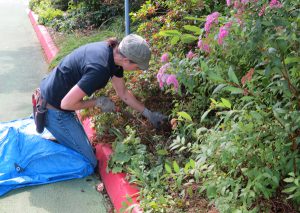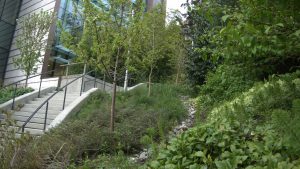
Seattle Children’s philosophy on sustainability is centered around its mission to help every child live the healthiest and most fulfilling life possible.
“When we do good things for the planet, we help take care of our patients and all children,” said Colleen Groll, Seattle Children’s manager of sustainability programs. “Children are one of the most affected populations by climate change and pollution, so it’s really important that we are a leader in reducing our impact on the environment.”
That organizational mindset and Seattle Children’s longstanding commitment to the environment recently inspired it to achieve certification as the nation’s first Salmon-Safe hospital campus. The distinction is attained by meeting peer-reviewed criteria and performance standards that demonstrate environmental stewardship in areas that directly impact the urban watershed. This includes minimizing impacts of development on sensitive aquatic and land resources; and protecting downstream water quality through landscape management practices, habitat restoration and facility performance—like waste reduction and responsible water use.
“As the first hospital to achieve Salmon-Safe certification, Seattle Children’s will be the leader of a new movement to create healthier urban watersheds,” said Dan Kent, Salmon-Safe co-founder and executive director. “We look forward to working closely with Seattle Children’s as it raises the bar for environmental management within the healthcare industry.”
A natural fit
Salmon-Safe is an independent nonprofit dedicated to helping transform land management practices so Pacific salmon can thrive in West Coast watersheds. Several salmon populations are currently listed as threatened in the Puget Sound region under the Federal Endangered Species Act.
“We have a large operation close to major waterways and we understand that runoff water from our campus eventually flows back into the local aquatic ecosystem,” Groll said. “We felt Salmon-Safe certification was important to pursue and aligned perfectly with our environmental priorities and commitment to the safety of our patients, families and community.”
Salmon-Safe sites undergo an annual verification process that includes a certified review of landscape management practices, storm water systems performance and other program elements.
Adding to a sustainable legacy
While Seattle Children’s journey to Salmon-Safe certification began two years ago, environmental stewardship has been a top priority for several decades. Seattle Children’s has garnered national recognition for its efforts, which include:
- Practice Greenhealth Top 25 Environmental Excellence Award, 2015-17
- Circle of Excellence Awards in 2016 for tracking greenhouse gas emissions and green building achievements
- Becker’s 50 greenest hospitals in America in 2015 and 2016
- LEED® Gold certification of Building Hope expansion in 2013
- Seattle Children’s Clinic and Surgery Center in Bellevue earned LEED® Gold certification in 2010
- 2010 Practice Greenhealth Partner for Change with distinction for outstanding environmental performance.
- 2008 Governor’s Award for Sustainable Practices.
With environmental care always top of mind, many Salmon-Safe requirements were already in place thanks to the efforts of grounds maintenance manager Jeff Hughes, who has worked at Seattle Children’s for 35 years.
“Jeff had done and continues to do a stellar job on our campus, particularly with stormwater runoff, constructing bio swales that help filter run off, incorporating native and drought-tolerant planting, and developing an integrated pest management system,” Groll said.
The Salmon-Safe certification required the hospital to also develop a more comprehensive campus-wide stormwater management plan, improve its documentation of landscape management practices and continue its pursuit of irrigation water use reduction and other conservation strategies.
“Salmon-Safe’s independent assessment team was impressed with Jeff’s ethos and ecologically thoughtful care of the site,” said Ellen Southard, Salmon-Safe Puget Sound manager. “We knew in our first meeting with him and Colleen that the Children’s Hospital team would make great community partners as we entered the healthcare sector.”

Momentum spurs future initiatives
Seattle Children’s is currently part of the Healthier Hospitals initiative, a national campaign to improve environmental health and sustainability in the healthcare sector. It has committed to all six Healthier Hospitals priority challenges: engaged leadership, healthier food, leaner energy, less water, safer chemicals and smarter purchasing.
Complete organizational support and commitment to sustainable practices and programs has Seattle Children’s on track to reach its strategic plan goals:
- Reduce energy use by 20% by 2020
- Reduce water use by 20% by 2020
- Divert 50% of waste through composting and recycling
- Reduce food waste by 25%
- Reduce ride-alone work commutes by workforce to 30% by 2030
As the hospital creates plans to expand its main campus, it will also create a wetland habitat for amphibians and more bio swales to help filter storm water runoff, while existing infrastructure improvements will continue with sustainability goals in mind, Groll said.
“There will always be more we can do to lessen our impact on the environment,” Groll said. “Seattle Children’s will continually work to improve every facet of our operations for the benefit of the environment and current and future generations.”
Resources:
- Washington State Recreation and Conservation Office – Salmon Species Listed Under the Federal Endangered Species Act
- Seattle Children’s Sustainability Program
- SalmonSafe.org

